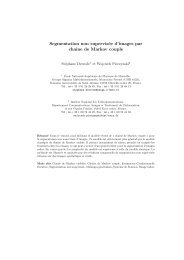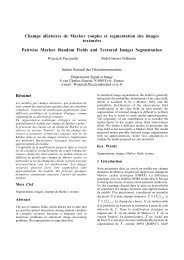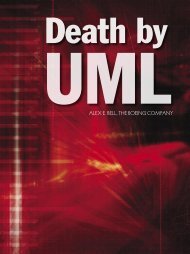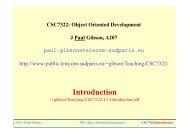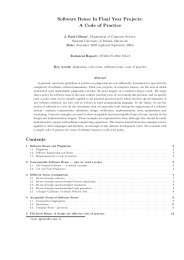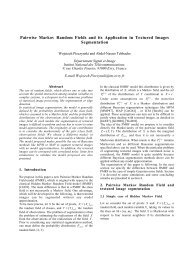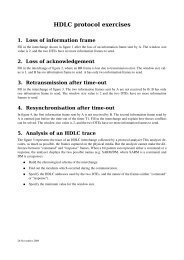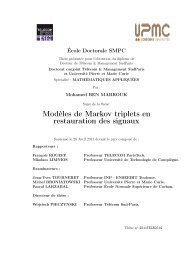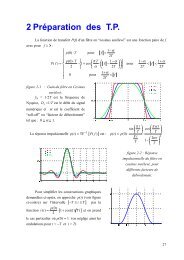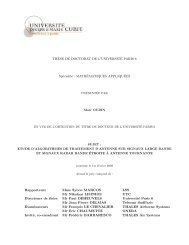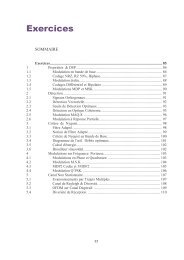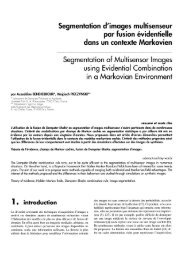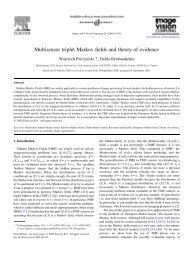Estimation Of Generalized Mixtures And Its Application ... - IEEE Xplore
Estimation Of Generalized Mixtures And Its Application ... - IEEE Xplore
Estimation Of Generalized Mixtures And Its Application ... - IEEE Xplore
You also want an ePaper? Increase the reach of your titles
YUMPU automatically turns print PDFs into web optimized ePapers that Google loves.
DELIGNON et al.: ESTIMATION OF GENERALIZED MIXTURES 1365generally of the form where defines thedistribution of conditional to If these distributionsare Gaussian, which is the most frequently considered case,each is of the form with being the meanand being the variance. The previous parameter estimationproblem is then the Gaussian mixture estimation problem. Inreal situations, the nature of the grey-level distribution canvary in time. For instance, the nature of the radar grey-leveldistribution of the sea surface depends on its state [8], thelatter depending on the weather. Thus, if we want to segmenta radar image where sea is one of the classes and we wishto dispose of an algorithm insensitive to weather conditions,we must consider the problem of estimating a generalizedmixture.The organization of the paper is as follows. In the next section,we address the generalized mixture estimation problemwithout reference to the image segmentation problem. Such amixture is defined and a method of its estimation based on theSEM is proposed.Section III contains a description of Pearson’s system, whichis a set of eight families of distributions, and different methodsfor estimating generalized mixtures whose components belongto this set are proposed. In fact, it is shown that the classicalmethods EM, SEM, or ICE can be generalized resulting ingeneralized EM, SEM, ICE (denoted by GEM, GSEM, GICE,respectively).In Section IV, we address the problem of unsupervisedimage segmentation, treating “local” and “global” methods.In the first case, GEM, GSEM, and GICE can be applieddirectly and we show that the use of their adaptive versionsis of interest. The second case, where the segmentation isperformed by the maximum posterior mode (MPM) [21],requires modeling by hidden Markov random fields. Differentparameter estimation methods have been proposed; let usmention Gibbsian EM [5], the algorithms of Zhang et al. [37],[38], stochastic gradient [35], the algorithm of Lakshmanan etal. [20], the algorithm of Devijver [16], and ICE. We considertwo of them (Gibbsian EM and ICE) and show that they canbe generalized in order to deal with the generalized mixturesestimation problem we are interested in.Section V contains results of some simulations, and segmentationsof three real radar images are presented.Conclusions are in the sixth section.II. GENERALIZED MIXTURE ESTIMATIONThe “classical” mixture estimation problem can be treatedwith methods like EM, SEM, or ICE. In this section, we willlimit our presentation to GSEM. Furthermore, for the sakeof simplicity, we shall consider the case of two classes andtwo families of distributions; its generalization is immediateand does not pose any problem. Let us note that the resultsof this section can be applied to any problem outside imagesegmentation.A. Classical Mixture <strong>Estimation</strong> and the SEM AlgorithmLet us suppose that the random variableswithare independent and identically distributed (i.i.d.),each taking its values in and inThe distributions of conditioned on areGaussiansrespectively. So, giventhe parameter defining the distribution ofisSEM is an iterative procedure thatruns as follows.1) Initialization: let be an initialguess of2) Calculation offromand, as follows.a) Compute, for each the distribution ofconditioned on If we denote by thebased densities this distribution is givenby(1)(2)b) Sample, for each a realization inaccording to the distribution above andconsiderthe “artificial” sampleof so obtained.c) Consider the partition ofdefined byd) Calculatebyand (3)3) Stop when the sequence stabilizes.B. <strong>Generalized</strong> Mixture <strong>Estimation</strong>Let us considera set of two families ofdistributions, a real random variable whose distributionbelongs either to or to anda sample of realizations of Let us temporarily assume thatwe dispose of a decision rule, which allows us todecide from in what set between and the distributionof lies. Such a decision rule, still called “ recognition,”will be made more explicit in what follows.(4)(5)



